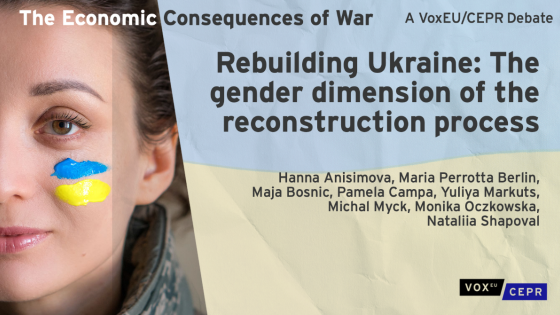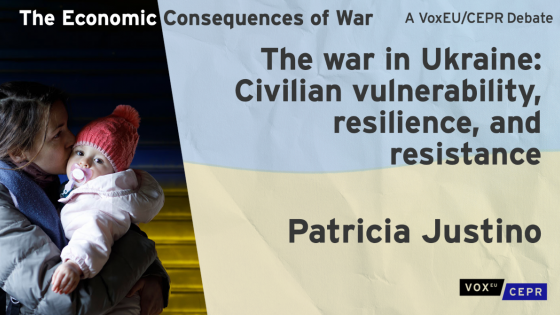In August 2022, in the midst of the full-scale Russian invasion, the Ukrainian government adopted a State Strategy for gender equality (Cabinet of Ministers of Ukraine 2022), reaffirming its commitment to eliminate gender-based discrimination in Ukraine, with a focus on empowering women. The Strategy is part of a wider legislative programme that has placed gender equality at the centre of Ukrainian public policy and has adopted Gender Responsive Budgeting (GRB) principles.
Before the war, Ukrainian women were more educated than men but less likely to participate in the labour force or hold senior positions in business or politics (World Economic Forum 2021). The war has thereafter exposed women and men to different risks and challenges (Berlin and Campa 2022). The recovery process presents a unique opportunity to address both pre-war and war-related gender inequalities. Gorodnichenko et al. (2022) noted the critical importance of planning Ukraine’s post-war reconstruction. In a new report (Anisimova et al. 2023) we contend that if the reconstruction is to result in sustainable development and tangible benefits for all Ukrainians, it must consider the gender dimension, and we identify the tools of gender responsive budgeting to apply in this process. This is consistent with the Ukrainian State Strategy, which recognises gender equality not only as a human right but also as a driver of economic growth and social development.
Gender responsive budgeting and post-war reconstruction
At the heart of gender responsive budgeting is the recognition of the potential for financial and fiscal policies to influence gender disparities. GRB is aimed at ensuring that government policies promote gender equality objectives and that adequate resources are allocated to achieving them (International Monetary Fund 2017).
To ensure fair and effective use of reconstruction funds in compliance with GRB principles, the process should consider the following:
- Participation: Consultation with population groups with different characteristics (e.g. gender, age, disability, and profession) should inform reconstruction priorities.
- Equity: The needs of minorities (e.g. people with disabilities) must not be neglected in policies that focus on the needs of the majority.
- Addressability: A reconstruction programme aimed at ‘everyone’ risks significant misallocation of funds, reaching ‘no one’.
The collection and analysis of gender-disaggregated data should also be prioritised.
Gender responsive budgeting and governance
Increasing women’s representation in Ukrainian political institutions
A major concern with the application of gender responsive budgeting principles is how effectively these can be prioritised, especially in times of crisis. We suggest that increasing women’s representation in Ukrainian politics could help address this concern. The gender composition of political institutions has been shown to make the allocation of public funds and the process of policymaking more representative of women’s preferences (Chattopadhyay and Duflo 2004, Lippmann 2022). Moreover, project proposals crafted by more gender-equal groups tend to be more representative of both women and men’s needs and priorities.
Literature in economics and political science also documents that, as more women are elected to political institutions, the average ‘quality’ of elected politicians tends to increase (Besley et al. 2017, Baltrunaite et al. 2019). Moreover, female policymakers are less likely to engage in corruption and patronage (Brollo and Troiano 2016, Dollar et al. 2001, Swamy et al. 2001), a dimension which will be closely monitored at the international level, and which is key in ensuring international support for reconstruction spending in Ukraine. Policies that increase women’s political representation could thus also help improve democratic institutions, a development that is especially important in light of Ukraine’s ambition to join the EU.
To ensure greater representation of women, some adjustments to the functioning of gender quotas in the Ukrainian electoral system should be considered, starting with more effective enforcement (excluding from the electoral competition lists that do not comply with the quota). Placement mandates warrant that candidates of each gender need to be strictly alternated on each electoral list (Esteve-Volart and Bagues 2012). In the system of double-preference voting voters express their preference for two candidates of different gender (Baltrunaite et al. 2019, Bohnet 2016.).
The European Integration Agency (UREIA)
Building on the proposal in Mylovanov and Roland (2023) to create an EU-affiliated agency to manage reconstruction funds, we suggest that gender responsive budgeting principles are used in the process of funds allocation within the European Integration Agency. Given that gender budgeting has been part of Ukraine’s public finance system for a number of years, there is likely a readily available supply of trained personnel who can work together with international experts.
We also suggest that in the European Integration Agency, as in Ukrainian politics in general, women must be well-represented. Recent empirical studies indicate that the personal traits of public procurement actors play a key role in influencing procurement practices and outcomes (Best et al. 2019, Decarolis et al. 2020). Gender-based variations in personal characteristics such as risk aversion and ethical values have been demonstrated to play a significant role, including in the context of corruption (Chaudhuri 2012).
Rebuilding the physical environment: The gender perspective
Many Ukrainian cities will need to be rebuilt from the ground. The built environment, through effects on employment, housing, open spaces, transportation, and environmental quality, has important consequences for many aspects of gender equality. When rethinking cities, questions such as zoning, connectivity and mobility, as well as more practical details such as the quality of sidewalks and lighting, need to be considered (Grant-Smith et al. 2017).
The layout and accessibility of transport infrastructure will affect the lives of those who are limited by safety concerns or who use mobility aids (such as wheelchairs or prams). These aspects have been shown to be particularly important for women, even determining life choices with long-lasting impacts (Borker 2021). Rebuilding with significant emphasis on how the city is used by different genders (Grieco and McQuaid 2012, Ghani et al. 2016) would benefit women in particular and facilitate their effective integration in the future aspects of socioeconomic development.
One important objective, serving the goal of energy self-sufficiency in the future of Ukraine, is increased energy efficiency. Recent literature finds that households with higher female decision power display higher energy efficiency (Li et al. 2019), while firms with more women on their boards source significantly more energy from renewables (Atif et al. 2021).
Rebuilding and strengthening Ukraine’s human capital: The gender perspective
Almost eight million Ukrainians have been forced to leave the country. 90% of them are women with their children. 68% of the five million internally displaced are women (UNWomen 2023). Supporting these women in returning to Ukraine and in reintegration, often in places other than those they had left, will be of vital importance to the process of reconstruction.
Active labour market policies for displaced individuals and returning migrants will be essential to improve the match between their skills and the local post-war labour market conditions. It has been shown that in settings with high employment gaps these programmes tend to be more effective for women (Bergman and van den Berg 2008). Skill training should also take into account gender dimensions existing in the Ukraine’s labour market. Women represent a large majority of Ukrainian teachers, and their skills can be utilised not only in schools, but also in adult education and retraining institutions. Similarly, most of the Ukrainian healthcare workers are women. Increasing the competence and skills of nurses to take over greater responsibilities for primary care will be one of the important reforms needed in the Ukrainian healthcare sector (Gorodnichenko et al. 2022).
International evidence proves that it is still likely that, when faced with institutional and informal care constraints, women are more likely to drop out of the labour market. Substantial reconstruction funding ought to be committed to ensure adequate care support directed to parents of young children and to those with care responsibilities of older family members. Such support will be particularly important for displaced families and returning international migrants, who may lack family support and social networks to organise informal care. Returning to pre-war high levels of coverage by institutional childcare of children aged 3-6 and extending the coverage to children below three years will be an important element of the reconstruction process in Ukraine.
The Ministry of Social Policy of Ukraine (2022) expects war veterans, primarily men, and their families to amount to five million. Building on previous experiences and existing programmes will be essential to address particular physical and mental health needs of this vulnerable group. Specific support will have to be offered also to victims of conflict-related sexual violence – mostly women.
According to UNICEF, the war in Ukraine has disrupted education for more than five million children (UNICEF 2023). As mounting evidence from the Covid-19 pandemic shows, such disruptions accumulate in the form of significant human capital losses (Gajderowicz et al. 2022, Contini et al. 2021), which post-war recovery will have to address. Home schooling and disrupted school routines might impose additional limitations on the education of girls who may be tasked with greater home and care responsibilities. Thus, it will be particularly important to closely monitor the school coverage and return to standard school attendance among girls, if needed pairing financial support to households with programmes designed to incentivise school attendance (Aygün et al. 2021).
Conclusions
If the post-war reconstruction process is to take the principles of ‘building-back-better’ seriously, recovery planning and execution must address social inequalities, not least along the gender dimension. The reconstruction process will offer a unique chance to set Ukraine on the path of inclusive, stable, and sustainable development. The application of gender responsive budgeting can help both in ensuring efficiency of allocation of the funds, and in strengthening the legitimacy for the provision of support by the international community.
References
Anisimova, H, M P Berlin, M Bosnic, P Campa, M Mych, M Oczkowska and N Shapoval (2023), “Rebuilding Ukraine: the Gender Dimension of the Reconstruction Process”, Free Policy Paper, March.
Atif, M, M Hossain, M S Alam and M Goergen (2021), “Does board gender diversity affect renewable energy consumption?”, Journal of Corporate Finance 66, 101665.
Aygün, A H, M G Kirdar, M Koyuncu and Q Stoeffler (2021), ”Keeping Refugee Children in School and Out of Work: Evidence from the World's Largest Humanitarian Cash Transfer Program”, IZA DP No. 14513.
Baltrunaite, A, A Casarico, P Profeta and G Savio (2019), “Let the voters choose women”, Journal of Public Economics 180, 104085.
Bergemann, A and G J van den Berg (2008), ”Active Labor Market Policy Effects for Women in Europe — A Survey”, Annales D’économie et de Statistique 91/92: 385–408.
Berlin, M P and P Campa (2022), “Gender-based Violence in Conflict”, Free Policy Brief, May.
Besley, T, O Folke, T Persson and J Rickne (2017), “Gender quotas and the crisis of the mediocre man: Theory and evidence from Sweden”, American Economic Review 107(8): 2204-2242.
Best, M C, J Hjort and D Szakonyi (2019), “Individuals and organizations as sources of state effectiveness”, NBER Working Paper 23350.
Bohnet, I (2016), What works, Harvard university press.
Borker, G (2021), “Safety First: Perceived Risk of Street Harassment and Educational Choices of Women”, World Bank Policy Research Working Paper, 9731.
Brollo, F and U Troiano (2016), “What happens when a woman wins an election? Evidence from close races in Brazil”, Journal of Development Economics 122: 28-45.
Cabinet of Ministers of Ukraine (2021), “On the approval of the Strategy for reforming the state finance management system for 2022-2025 and the plan of measures for its implementation”, Resolution, No. 1805-r.
Cabinet Ministers of Ukraine (2022), “State strategy for ensuring equal rights and opportunities for women and men for the period until 2030 and approval of the operational plan for its implementation for 2022-2023”, Resolution No. 752-p.
Chaudhuri, A (2012), “Gender and Corruption: A Survey of the Experimental Evidence”, In D Serra and L Wantchekon (eds.), New Advances in Experimental Research on Corruption, Research in Experimental Economics, Vol. 15, Emerald Group Publishing Limited, Bingley, 13-49.
Chattopadhyay, R and E Duflo (2004), “Women as policy makers: Evidence from a randomized policy experiment in India”, Econometrica 72(5): pp.1409-1443.
Contini, D, M L Di Tommaso, C Muratori, D Piazzalunga and L Schiavon (2021), “The COVID-19 Pandemic and School Closure: Learning Loss in Mathematics in Primary Education”, IZA DP No. 14785.
Decarolis, F, L M Giuffrida, E Iossa, V Mollisi and G Spagnolo (2020), ”Bureaucratic competence and procurement outcomes”, The Journal of Law, Economics, and Organization 36(3): 537-597.
Dollar, D, R Fisman and R Gatti (2001), “Are women really the ‘fairer’ sex? Corruption and women in government”, Journal of Economic Behavior & Organization 46(4): 423-429.
Esteve-Volart, B and M Bagues (2012), “Are women pawns in the political game? Evidence from elections to the Spanish Senate”, Journal of Public Economics 96(3-4): 387-399.
Gajderowicz, T, M Jakubowski, H A Patrinos and S Wrona (2022), “Capturing the Educational and Economic Impacts of School Closures in Poland”, IZA Discussion Paper No. 15787.
Ghani, F, J N Rachele, S Washington and G Turrell (2016), "Gender and age differences in walking for transport and recreation: Are the relationships the same in all neighborhoods?", Preventive medicine reports 4: 75-80.
Gorodnichenko, Y, I Sologoub and B Weder di Mauro (2022), Rebuilding Ukraine: Principles and Policies, CEPR Press.
Grant-Smith, D, N Osborne and L Johnson (2017), “Managing the challenges of combining mobilities of care and commuting: an Australian perspective”, Community, Work & Family 20(2): 201-210.
Grieco, M and R W McQuaid (2012), "Gender and transport: transaction costs, competing resources and transport policy gaps", Research in Transportation Economics 34(1).
International Monetary Fund (2017), “Gender Budgeting in G7 Countries”, IMF Policy Paper.
Li, J, J Zhang, D Zhang and Q Ji (2019), ”Does gender inequality affect household green consumption behaviour in China?”, Energy Policy 135, 111071.
Lippmann, Q (2022), “Gender and lawmaking in times of quotas”, Journal of Public Economics 207, 104610.
Ministry of Social Policy of Ukraine (2022), “On Methodological Recommendations for Implementing a Gender Approach and a Human Rights-based Approach at the Local Community Level”, Order No. 359.
Mylovanov, T and G Roland (2023), “Ukraine’s needed postwar institutional changes”, VoxEU.org, 19 January.
Swamy, A, S Knack, Y Lee and O Azfar (2001), “Gender and corruption”, Journal of Development Economics 64(1): 25-55.
UNICEF (2023), “Ukraine War Disrupts Education for More than Five Million Children", UN News: Global perspective Human stories, 23 January.
UNWomen (2023), “Statement on Ukraine by Sima Bahous, UN Under-Secretary-General and UN Women Executive Director”, 27 February.
World Economic Forum (2021), Global Gender Gap Report 2021.











